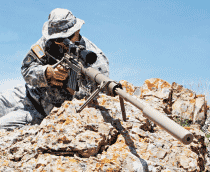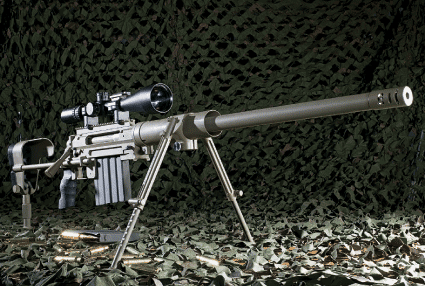With the current advancement in bullet manufacturing and the use of blended metal technology has come the creation of near-perfect high-ballistic coefficient (BC) bullets that allow shooters to stretch the legs of the big-bore guns to distances once thought impossible.
 For many shooters, 500 yards is a long shot, and to a skilled marksman with a precision rifle, solid optics and superb ammunition, 1,000 yards is just the starting point. With the .408 CheyTac, first-round accurate hits are achievable at distances more than 2,000 yards. Over the last few years the need of our military to “reach out and touch someone” has been an understatement. Today’s snipers have the need to extend their engagement distances beyond what was possible on yesterday’s battlefield. Snipers have made some incredible shots with their M82 Barrett .50 caliber rifles since the early 1990s.
For many shooters, 500 yards is a long shot, and to a skilled marksman with a precision rifle, solid optics and superb ammunition, 1,000 yards is just the starting point. With the .408 CheyTac, first-round accurate hits are achievable at distances more than 2,000 yards. Over the last few years the need of our military to “reach out and touch someone” has been an understatement. Today’s snipers have the need to extend their engagement distances beyond what was possible on yesterday’s battlefield. Snipers have made some incredible shots with their M82 Barrett .50 caliber rifles since the early 1990s.
As technology continues to advance, the time has come to have more accurate purpose-built weapons systems designed to use these highly advanced rounds of ammunitions being produced to enhance the extreme long-range sniping efforts.
Advertisement — Continue Reading Below
The introduction of these calibers with superior ballistic advantages has not only become quite popular but has now become the standard for tactical superiority, to allow for mission success while limiting collateral damage.
For years British snipers have used the .338 Lapua Mag as their long-range platform to augment their Accuracy International .308 rifles. In fact, the British have almost totally abandoned their .308 rifles and have for the most part gone to the .338 Lapua Mag caliber for its effective long-range capabilities and enhanced penetration with the ability to be a great tool in the urban environment. A similar situation is also occurring here in the United States.
The US military and numerous federal law enforcement agencies have tested, and continue to conduct extensive testing of the .338 Lapua Mag to fill the gap between their primary weapons system and their extreme long-range systems. But still there’s the need to shoot flatter, faster and more accurately at greater distances than even the .338 Lapua Mag can reach.
Advertisement — Continue Reading Below
That’s where the .408 CheyTac comes into the picture.
For those of you who haven’t heard about the .408 CheyTac until now, you have been missing out. CheyTac Intervention has been in business since 2003. Corey Kupersmith, who owns the company, is a civilian shooting enthusiast who bought the company out of his love for long-range shooting.
Gun Details
The CheyTac M-200 in .408 caliber rifle has a CNC machined receiver with an attached Mil-Std-1913 base, integral bipod, a 30-inch detachable steel barrel, 3.5-pound trigger and an extremely effective muzzle break. The rifle weighs 27 pounds and measures 55 inches with its retractable stock fully extended.
Advertisement — Continue Reading Below
The CheyTac fires two primary rounds, a 419-grain bullet with a BC of 0.94 moving at 2900 fps (feet per second) and a 305-grain round with a BC of 1.12 moving at 3300 fps, both of which are lathed turned bullets made out of a copper nickel alloy, which allows one to easily reach out to 2500 yards and beyond.
Jamison International currently makes .408 CheyTac ammunition and components. CheyTac ammunition can be ordered through CheyTac or directly from Jamison, which rumor has it, will be changing its name to CheyTac Ordnance in the coming year.
Recently, a new .408 armor piercing round was designed and developed by Dr. John D. Taylor with the help of William Wordman. The new .408 AP round is a 370-grain projectile with a standard velocity of 3100 fps with capabilities that are superior to the M2 ball and the M8 .50 caliber due to its efficiency and the high energy of its patent pending lathed turned projectile. Made from a proprietary copper alloy, the bullet is drilled and plugged with a tungsten carbide penetrator core.
Advertisement — Continue Reading Below
The weight and thickness of the projectile’s outer copper alloy body allows the bullet to act like a buffer letting the tungsten carbide penetrator stay solid for a longer period of time before it loses its energy. Currently, not a lot of test information has been publicly released about this new round. I have been told that the new AP round will easily penetrate through a 1-inch certified AR500 piece of steel at 100 yards, and a ½-inch certified AR500 steel plate at 775 yards.
Not only does CheyTac build one of the most accurate extreme long-range rifles on the market, they offer some of the most advanced training for shooters looking to reach out past the 2500-yard mark. If your weapon system cannot shoot accurately at 2500 yards, CheyTac will teach you how operate in its last 25 percent of its capable envelope, not its first 75 percent, which usually most skilled rifleman can already accomplish. The arduous mountainous terrain, long rolling plains, and extreme engagement distances that CheyTac offers resemble the real world conditions commonly found on the battlefield in Afghanistan.
CheyTac offers a variety of training for civilians, and they offer restricted custom type training for the military and law enforcement agencies needing to employ the .408 CheyTac or any other extreme long-range weapons system. In addition to this basic extreme long-range class, they offer an 8-hour ABC (Advanced Ballistic Calculator) and CABC (Civilian Advanced Ballistic Calculator) course, and an 8-hour armorer’s course for the .408 CheyTac weapons system.
Advertisement — Continue Reading Below
Training Details
I recently had the opportunity to spend four days with Team CheyTac at their training facility.
Upon meeting our head instructors Jason and Dave Durham, a very knowledgeable father/son combination, and Kevin Houcek, we proceeded into the classroom for the initial safety brief and introductions, and then we spent a good portion of the morning getting familiar with the ABC and CABC. We would soon learn that in order to achieve rounds on target we would have to know exactly how to use and plug in accurate information into the hand held ballistic calculators.
As you probably know when using any ballistic software on your home computer or a handheld device, “junk in will get you junk out,” so more precise data in will help you achieve first round hits. After lunch we had a ballistics class and fundamentals of marksmanship class. We were given a quick break and we loaded up the vehicles and headed out to the 100-yard zero range to chronograph, zero and get some basic data in our new environment. Upon completion, we packed up our gear and went back to the shop to clean the weapons and to debrief the day’s training.
Advertisement — Continue Reading Below
On day two we found ourselves heading to CheyTac’s range where we would get ample shooting from 100 to 2000 yards. The complete day was spent on making sure that everyone understood the fundamentals of marksmanship, and that they could effectively employ the CheyTac weapons systems using the ABC or CABC handheld devices. Upon the conclusion of training it was back to the shop for debriefing and to clean weapons and equipment to get all the dust off. As a side note, the CheyTac flat range will allow for shots out to 3000 yards.
Day three found us moving up to the range bright and early. The drive up to our shooting area took about 35 minutes to get there. This allowed us to enjoy some of the most scenic views of the valley, plains and mountains that Idaho has to offer. Upon reaching the pass we left the vehicles, and unloaded the gear and got ready to stretch our legs. I started looking for targets. When pointed in the right direction I was barely able to make out the small white specs that these guys call targets over the numerous valleys and ridges located on the large mountainside.
My shooting partner Rob Ormond and I got down and made a quick range card, and started to range the various targets across the mountain. Once our range card was complete we started to input data into our ABC and the target engagements began. We quickly found achieving first round hits at ranges of 1500 yards with the .408 CheyTac to be a simple task. We spent the complete day on the range working over firing solutions and engaging targets in 25-mph winds throughout the day out to 2200 yards.
Advertisement — Continue Reading Below
Day four took us back out to Arco Pass to again ring out steel and see how much info we retained and how well we were using the ABC/CABCs. My shooting partner and I spent the day seeing how fast we could input the data into the ABC, working our way through the target arrays with the least amount of shots.
This also provided us the chance to work on communication between shooter and observer while engaging multiple targets at multiple ranges, elevations, angles with various wind directions and speeds.
Course Impressions
The training we received over those four days was top notch, to say the least. There was very little down-time and plenty of shooting each day. I was highly impressed with the accuracy, and the simplicity of the ABC and the ability to put rounds on target and achieve first-round hits at 2000 yards. The .408 CheyTac M-200 or M-310 weapons systems are easy to manage and shoot. I know there are people out there saying, yeah right, but to prove to you how simple and easy this weapons system is to shoot I want to share with you a little story from our training.
Advertisement — Continue Reading Below
We had Officer Shelly Pharis of the Hailey PD, who was up on the range for the last day of the training. Pharis is a small framed but tough lady with an ambition to get into tactical shooting. I will have to say in my many years of shooting I have never seen a woman who listened to, applied and understood the fundamentals of marksmanship and applied them while shooting these big .408s.
Pharis was able to apply the data on the rifle to make a second-round hit on an 18×18-inch piece of steel at 2000 yards using the CheyTac M-200. She had just missed making a first round hit by roughly 6 inches off the right side of the plate due to being slightly off with the wind call. That was pretty impressive, if you ask me.
Final Notes
If you’re an individual who is looking to take some extreme long-range training and you don’t own an extreme long range weapons system that can achieve these distances, no problem. You can rent one of the CheyTac’s .408 systems for $150 dollars on top of your course fee, and you can purchase the required ammunition for the course through them as well. Upon completion of the course if you decide to buy a .408 CheyTac within six months of your training, CheyTac will discount your new rifle purchase for the $150 rental fee you paid.
I highly recommend this course to anyone who wants to test their skill at ranges that in the past could only be dreamed about. The days of “luck shots” at distances over 2000 yards are gone. You can now effectively and consistently achieve a successful first-round hit using these advancements in weapons, equipment and ammunition.























